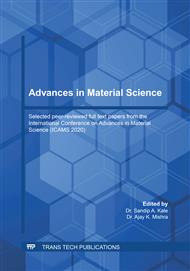[1]
S. Ismail, M. Ramli, Mechanical strength and durability properties of concrete containing treated recycled concrete aggregates under different curing conditions, Construction and Building Materials 155 (2017) 296-306.
DOI: 10.1016/j.conbuildmat.2017.08.076
Google Scholar
[2]
B. Qi, J. Gao, F. Chen, D. Shen, Evaluation of the damage process of recycled aggregate concrete under sulfate attack and wetting-drying cycles, Construction and Building Materials 138 (2017) 254–262.
DOI: 10.1016/j.conbuildmat.2017.02.022
Google Scholar
[3]
A. Gonzalez-Corominas, M. Etxeberria, C.S. Poon, Influence of steam curing on the pore structures and mechanical properties of fly-ash high performance concrete prepared with recycled aggregates, Cement and Concrete Composites 71 (2016) 77-84.
DOI: 10.1016/j.cemconcomp.2016.05.010
Google Scholar
[4]
N. Haghighatnejad, S.Y. Mousavi, S.J. Khaleghi, A. Tabarsa, S. Yousefi, Properties of recycled PVC aggregate concrete under different curing conditions, Construction and Building Materials 126 (2016) 943–950.
DOI: 10.1016/j.conbuildmat.2016.09.047
Google Scholar
[5]
Vineetha V. V., A. Aravind, Mechanical Properties of Hybrid Fibre Reinforced Concrete using Recycled Aggregate Vineetha V. V1 and Arya Aravind2, International Journal of Advances in Scientific Research and Engineering 03(5) (2017) 47-56.
Google Scholar
[6]
I. Marie, R. Mujalli, Effect of design properties of parent concrete on the morphological properties of recycled concrete aggregates, Engineering Science and Technology, an International Journal 22(1) (2019) 334-345.
DOI: 10.1016/j.jestch.2018.08.014
Google Scholar
[7]
S. Ismail, M. Asri Abd Hamid, Z. Yaacob, D. Ismail, H. Md Akil, Mechanical properties and microstructure of recycled mortar reinforced with hybrid fiber, 2018 7(4) (2018) 6.
DOI: 10.14419/ijet.v7i4.12279
Google Scholar
[8]
L. Restuccia, C. Spoto, G.A. Ferro, J.-M. Tulliani, Recycled mortars with C&D waste, 21st European Conference on Fracture, ECF21, Elsevier, Catania, Italy, 2016, pp.2896-2904.
DOI: 10.1016/j.prostr.2016.06.362
Google Scholar
[9]
G.M. Cuenca-Moyano, M. Martín-Morales, I. Valverde-Palacios, I. Valverde-Espinosa, M. Zamorano, Influence of pre-soaked recycled fine aggregate on the properties of masonry mortar, Construction and Building Materials 70 (2014) 71–79.
DOI: 10.1016/j.conbuildmat.2014.07.098
Google Scholar
[10]
V. Corinaldesi, G. Moriconi, Behaviour of cementitious mortars containing different kinds of recycled aggregate, Construction and Building Materials 23(1) (2009) 289-294.
DOI: 10.1016/j.conbuildmat.2007.12.006
Google Scholar
[11]
P.S. Martínez, M.G. Cortina, F.F. Martínez, A.R. Sánchez, Comparative study of three types of fine recycled aggregates from construction and demolition waste (CDW), and their use in masonry mortar fabrication, Journal of Cleaner Production 118 (2016) 162-169.
DOI: 10.1016/j.jclepro.2016.01.059
Google Scholar
[12]
M. Braga, J.d. Brito, R. Veiga, Incorporation of fine concrete aggregates in mortars, Construction and Building Materials 36 (2012) 960-968.
DOI: 10.1016/j.conbuildmat.2012.06.031
Google Scholar
[13]
Z. Zhao, S. Remond, D. Damidot, W. Xu, Influence of fine recycled concrete aggregates on the properties of mortars, Construction and Building Materials 81 (2015) 179-186.
DOI: 10.1016/j.conbuildmat.2015.02.037
Google Scholar
[14]
I. Vegas, I. Azkarate, A. Juarrero, M. Frias, Design and performance of masonry mortars made with recycled concrete aggregates Material Construction 59(295) (2009) 5-18.
DOI: 10.3989/mc.2009.44207
Google Scholar
[15]
L. Li, C.S. Poon, J. Xiao, D. Xuan, Effect of carbonated recycled coarse aggregate on the dynamic compressive behavior of recycled aggregate concrete, Construction and Building Materials 151 (2017) 52–62.
DOI: 10.1016/j.conbuildmat.2017.06.043
Google Scholar
[16]
J. Xiao, L. Li, L. Shen, C.S. Poon, Compressive behaviour of recycled aggregate concrete under impact loading, Cement and Concrete Research 71 (2015) 46-55.
DOI: 10.1016/j.cemconres.2015.01.014
Google Scholar
[17]
W. Li, Z. Luo, C. Long, C. Wu, W.H. Duan, S.P. Shah, Effects of nanoparticle on the dynamic behaviors of recycled aggregate concrete under impact loading, Materials & Design 112 (2016) 58-66.
DOI: 10.1016/j.matdes.2016.09.045
Google Scholar
[18]
ASTM International, ASTM C150 / C150M-20, Standard Specification for Portland Cement, ASTM International, West Conshohocken, PA, (2020).
Google Scholar
[19]
ASTM International, ASTM C305-14, Standard Practice for Mechanical Mixing of Hydraulic Cement Pastes and Mortars of Plastic Consistency, ASTM International, West Conshohocken, PA, (2014).
DOI: 10.1520/c0305-06
Google Scholar
[20]
ASTM International, ASTM E9-19, Standard Test Methods of Compression Testing of Metallic Materials at Room Temperature, ASTM International, West Conshohocken, PA, (2019).
Google Scholar
[21]
S. Ismail, M.A. Abd Hamid, Z. Yaacob, Effect of the Fine Recycled Aggregates on the Dynamic Compressive Behavior of Recycled Mortar, Materials Science Forum 991 (2020) 62-69.
DOI: 10.4028/www.scientific.net/msf.991.62
Google Scholar
[22]
S. Ismail, M. Ramli, EFFECT OF HYBRID FIBER ON THE MECHANICAL PROPERTIES OF RECYCLED AGGREGATE CONCRETE, Jurnal Teknologi (Sciences & Engineering) 80(5) (2018) 1-12.
DOI: 10.11113/jt.v80.9736
Google Scholar
[23]
G.G. Vaishali, H.S. Rao, Strength and Permeability Characteristics of Fiber Reinforced High Performance Concrete with Recycled Aggregates, Asian Journal of Civil Engineering (Building and Housing) 13(1) (2012).
Google Scholar
[24]
V. Vytlačilová, The fibre reinforced concrete with using recycled aggregates, International Journal of Systems Applications, Engineering & Development 5(3) (2011).
Google Scholar
[25]
H.A. Mesbah, F. Buyle-Bodin, Efficiency of polypropylene and metallic fibres on control of shrinkage and cracking of recycled aggregate mortars, Construction and Building Materials 13(8) (1999) 439-447.
DOI: 10.1016/s0950-0618(99)00047-1
Google Scholar
[26]
C.X. Qian, P. Stroeven, Development of hybrid polypropylene-steel fibre-reinforced concrete, Cement and Concrete Research 30(1) (2000) 63–69.
DOI: 10.1016/s0008-8846(99)00202-1
Google Scholar
[27]
Z. Deng, H. Cheng, Z. Wang, G. Zhu, H. Zhong, Compressive behavior of the cellular concrete utilizing millimeter-size spherical saturated SAP under high strain-rate loading, Construction and Building Materials 119 (2016) 96-106.
DOI: 10.1016/j.conbuildmat.2016.05.018
Google Scholar


